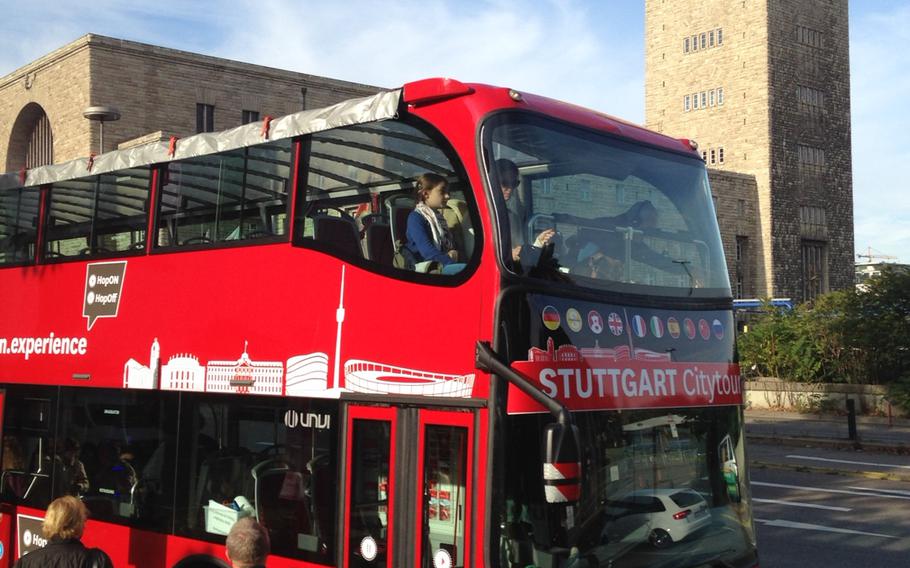
Stuttgart, Germany, offers year-round bus tours that allow riders to hop on and off at various sites. A 24-hour bus pass costs 15 euros. (John Vandiver/Stars and Stripes)
I’ve seen the ubiquitous red double-decker bus zoom past too many times to count. Near the Mercedes-Benz Museum, around Schlossplatz and patrolling the bucolic hills surrounding Stuttgart, Germany.
I’ve even watched it, almost daily, pass the U.S. Army’s Robinson Barracks. Recently, I decided it was time to get on board and see what it was all about.
The tour starts at the city tourism center on Königstrasse, across from Stuttgart’s main train station. The tour costs 15 euros and lasts roughly 100 minutes if you stay on the bus and listen to the recorded narration of the city’s history. Or you can hop on and off at various stops to explore museums and scenic walking trails.
The first bus stop is the Schlossplatz, the unofficial heart of Stuttgart, where the Old Castle and the New Castle are situated.
For anyone stationed in the area, there probably isn’t much that’s new to explore here. It’s the main city square with all that entails — scores of shops, cafes, restaurants and museums.
After a quick tour through the city center, the bus winds through Stuttgart’s mainly working-class east side. At the start of the Industrial Revolution, Stuttgart was a small city, with only about 20,000 inhabitants. That soon changed, and industry was a big part of the reason.
In the east, housing colonies for workers were set up that brought workers a relatively high quality of life. Homes at the time included running water and gardens — and the bus takes you past some of those that still stand.
The tour hits various sights, such as a kitschy museum dedicated to the pig — the Schweinemuseum purports to house the biggest collection of pig memorabilia in the world. Probably the most popular stop is the renowned Mercedes-Benz Museum in Bad Canstatt, Stuttgart’s oldest residential zone.
After passing the Mercedes museum, the bus climbs the hills on the north side of town, stopping near Robinson Barracks. Here, riders can stroll through the hilly vineyards overlooking the city.
While Germany is famous for its beer, Stuttgart is arguably more of a wine town. Annual wine consumption in Stuttgart is twice the rate of the rest of Germany — a little trivia tidbit courtesy of the recorded tour bus guide.
While I generally find recorded guides sleep-inducing, this tour features a nice conversation (in English) between a grandfather and grandson, who together explore the history of Stuttgart. Sure, it was kind of corny, but it kept my attention.
The bus then heads for Killesberg Park, a quiet green space with lots of walking trails. The Weissenhof estate, a collection of Bauhaus-style homes considered to be an important 20th-century architectural achievement, is also located here.
While much of Stuttgart lacks the kind of medieval toy-town charm you find in other cities in the area — a consequence of World War II bombing that leveled most of the city — there is much to appreciate here.
Stuttgart is certainly not New York or Paris, but a tour through Germany’s sixth-largest city offers a good overview for both the day-tripper and newcomer. It also serves as a good reminder of just how lovely Stuttgart is for those who have been around awhile.
Stuttgart city bus tour TICKETS Buy them on the bus or at the tourism office on Königstrasse.
TIMES In November and December, tours run at 10:30 a.m., 12:30 p.m., 2:30 p.m. and 4:30 p.m. weekdays; hourly from 10:30 a.m. to 4:30 p.m. Saturdays and Sundays. January through March, tours run 10:30 a.m., 12:30 p.m., 2:30 p.m. and 4:30 p.m. daily. April through October, daily tours run hourly from 10:30 a.m. to 4:30 p.m.
COSTS A day pass costs 15 euros.
FOOD None offered on the tour, but you can find plenty of places to eat when you hop off the hop-on, hop-off bus.
INFORMATION Stuttgart tourism website: www.stuttgart-tourist.de/en